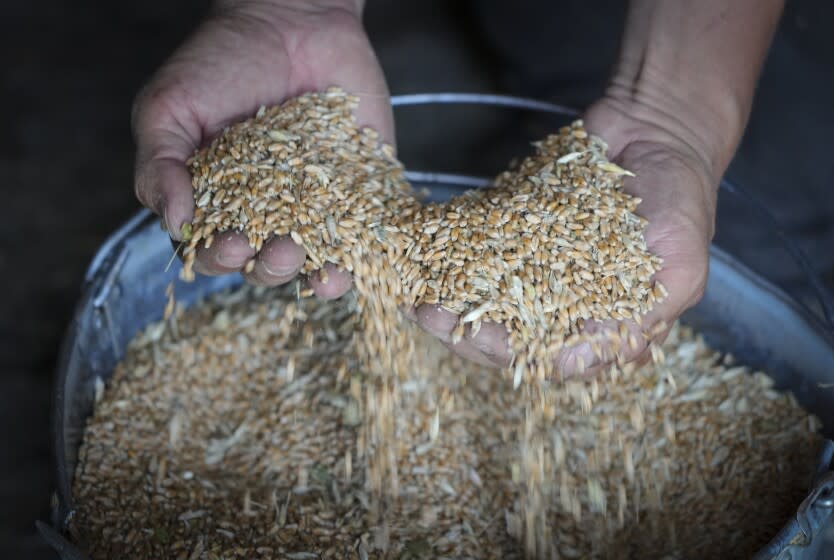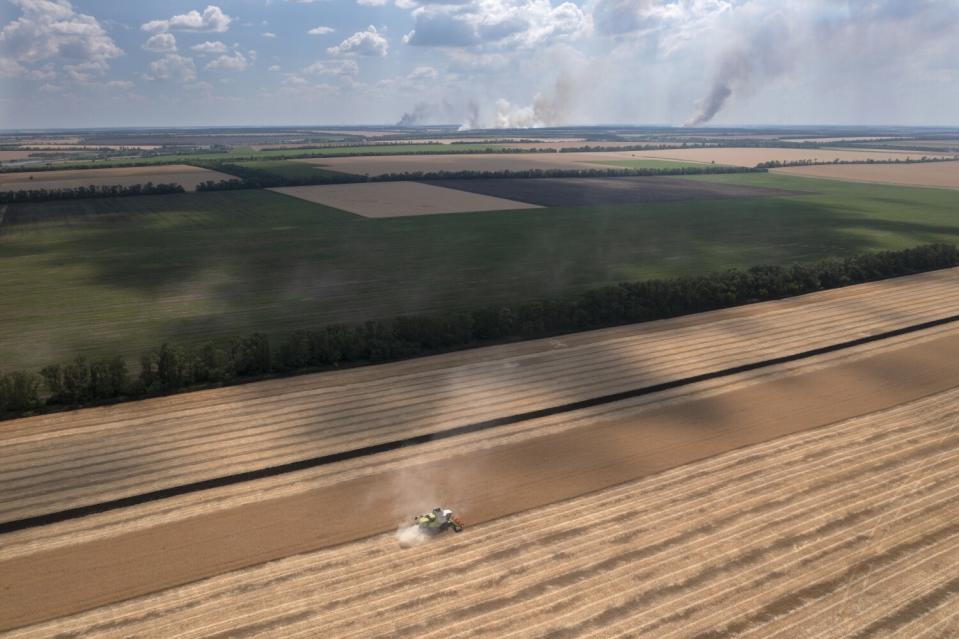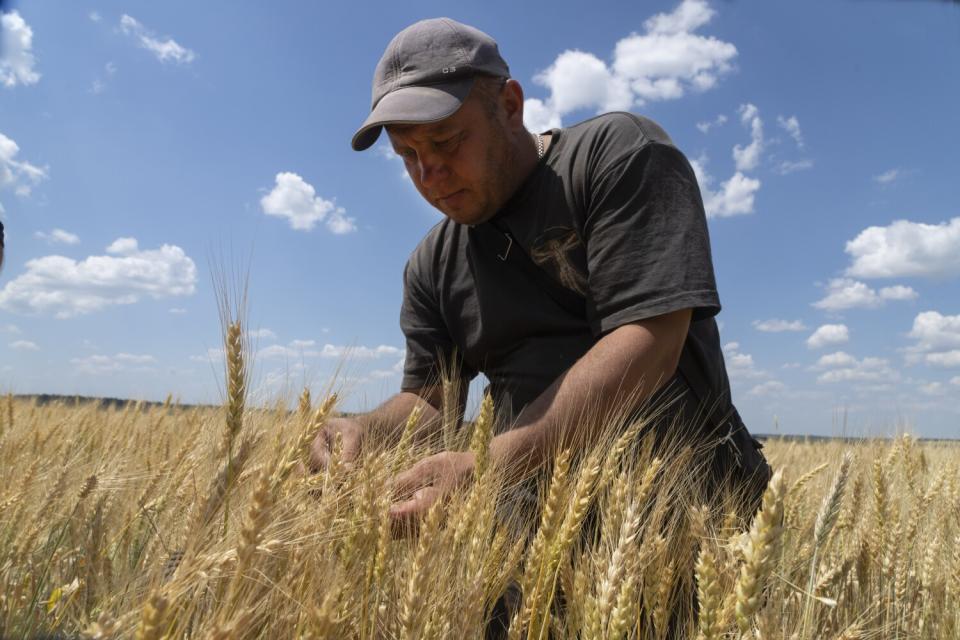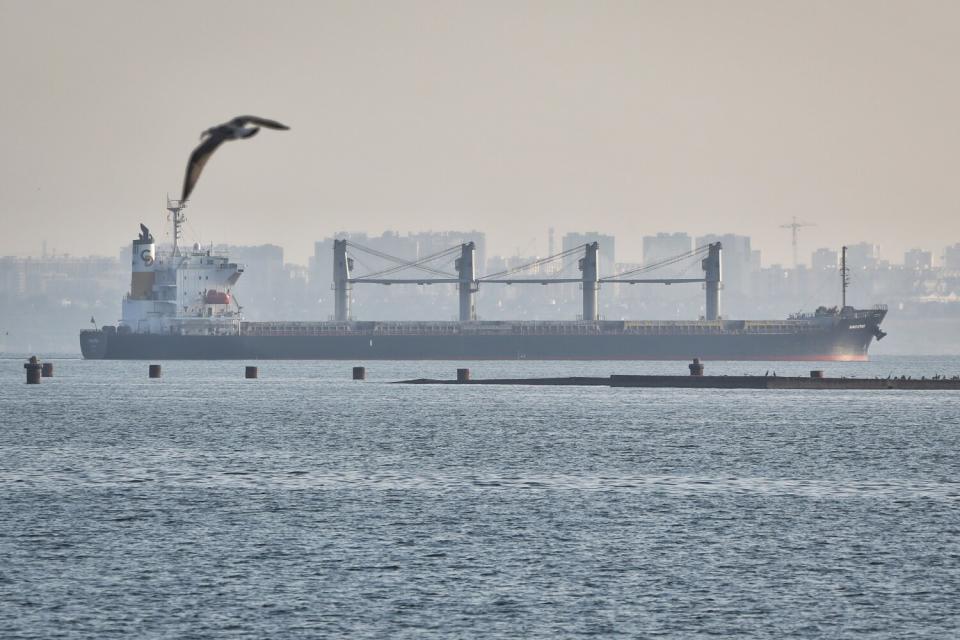War brings desperation and danger to Ukraine's farmers — and the world feels the pain

On a ferociously hot summer morning, a pair of tractors rumbled through a field of green, spraying squat sunflower stalks ahead of a harvest that has taken on greater significance than ever beyond this farm outside the central Ukrainian city of Dnipro.
Russia’s invasion of Ukraine upended the workings of what before the war was the world’s fourth-largest grain exporter. Almost six months into Moscow’s blockade of the Black Sea, the primary outlet for Ukraine’s wheat and oilseed exports, more than 22 million tons of grain and other crops remain stranded inside the country, with nowhere to go and fewer and fewer places for storage.
An internationally brokered deal began allowing some cargo ships to set sail from Ukraine last week. But their freight represents a tiny fraction of the total awaiting liberation. Worse yet, the logjam is set to grow, Ukrainian President Volodymyr Zelensky said, with the 2022 wheat harvest already being reaped while last year's sits trapped.
Countries that rely on Ukrainian wheat are already suffering. On top of pandemic supply-chain disruptions and Western sanctions on Russian oil and gas, the sharply reduced wheat supplies have already triggered a 25% increase in the price of bread in war-torn, poverty-racked Yemen. In Nigeria, another major importer of Ukrainian wheat, the price increase is double that.
As a result of that additional stress, the number of "people marching to starvation" around the globe has risen to 345 million, World Food Program chief David Beasley told the House Foreign Affairs Committee on July 20. About 50 million people in 45 countries are "knocking on famine’s door," he added.

It’s not just grains in short supply. Before the war, Ukraine exported an average of 430,000 tons of sunflower oil per month, making it responsible for roughly 42% of the world’s supply; its disruption spiked the price per metric ton (2,205 pounds) by 50%.
“It’s a compounded problem,” said Nader Wansa, who heads Wansa Group Commodities, a British-based firm. “I’ve been in the markets for a decade-plus. I’ve never seen anything that is a dwindling spiral like this.”
Inside Ukraine, it’s the opposite problem, said Dmitri Yemelchenko, the production director for KSG Agro, a Dnipro-based agricultural holding company that cultivates wheat, sunflower and rapeseed among other crops. It also operates a pork-processing plant.
A burly man whose muscular build, unwrinkled skin and broad cleft chin give him the look of a Ukrainian Buzz Lightyear, Yemelchenko sat in the conference room of KSG’s headquarters in downtown Dnipro, his face seemingly stuck in a permanent scowl as he considered what he called “a major mind-breaking exercise” facing his business.

“We don’t know what to plant. Regarding grains, it’s a catastrophic collapse of the market. There’s so much wheat here that we’re unable to export,” he said, adding that before the war he could expect to get more than $272 per metric ton.
‘“I’d be happy with any solution, but the question is how to change so we can stay profitable at such a cost base.”
At the start of Russia's Feb. 24 invasion, the price cratered to $85 per metric ton before recovering to about $100 after news of the accord. But wheat costs $200 per metric ton to cultivate — or, at least, it did before the war, Yemelchenko said.
“Diesel? It’s now two and a half times more," he said. Fertilizers, which depend on natural gas supplies in their production, and pesticides, a lot of which were supplied by Russia, have also shot up in price.
With Ukraine’s southern sea ports closed — in peacetime, they handled roughly 98% of Ukraine’s exports in grain and oilseeds — KSG had been forced to truck its loads to the border. The distance and long delays added $200 to $300 per truckload in transport costs.
The deal to unblock the Black Sea should help, but Yemelchenko said KSG would still have to contend with taking its produce from Dnipro to the nearest loading point on the Danube River, adding $100 in expenses, at least until the shipping deal holds and more Ukrainian ports are included.

One way KSG has tried to stay afloat is to focus on the more expensive crops in its portfolio, ramping up production of oilseeds, including sunflower, which remains profitable despite tumbling prices. Another cash crop is rapeseed, which KSG is able to export across Ukraine’s land borders to clients in France.
But it’s still a risk, said Vasili Gurin, the 42-year-old director at KSG’s farms in Novopokrovka, a village on the banks of the Komyshuvata Sura river, some 32 miles southwest of Dnipro.
“Well, it was profitable last year. How it will be this year? Who knows,” he said, explaining that other rapeseed exporters who used the sea route were likely to cause a glut in the market.
Another issue is that the demands of crop rotation mean that many plots of land would have to be used for money-losing seeds or just remain fallow, Gurin added, as he gazed at the tractors moving to another field.
“Two years ago we planted wheat in this part. Last year it was corn and now sunflower,” he said.
“If we plant sunflower here again, the harvest ends up being half the amount, and the plants are less healthy. It just wouldn’t work, not even with pesticides.”
Besides, with Russia’s shift in its military campaign to the vast steppes of Ukraine’s eastern and southern regions, KSG and others have even less of a solution for the very real danger facing farmers trying to do their job in what has become a battleground.
That campaign, with its relentless artillery barrages, has already transformed wide tracts of farmland into cratered, Swiss cheese-like landscapes. Farming hamlets have become an arena for run-’n’-gun tank battles, with grain silos, agricultural equipment depots and vegetable storage facilities destroyed in the fight — part of a deliberate policy by Russian troops to target Ukraine's agricultural industry, Ukrainian authorities allege.
“Of the 22,000 hectares [about 85 square miles] we operate on, almost a third are in areas near the front line,” Yemelchenko said.
He scrolled through photos on his phone before landing on a picture of a cluster bomblet hidden among green stalks of wheat. It was from a group of fields covering 2,500 hectares, or about 9½ square miles, between the Kryvyi Rih district and Kherson province. The port city of Kherson fell to Russian forces early in the war.
“We had prepared that area, but eventually we didn’t plant anything on any of those 2,500 hectares. The military said we couldn’t even go there,” Yemelchenko said.
Some of KSG’s employees have already experienced those dangers firsthand. Ivan, a 35-year-old who gave only his first name for reasons of privacy, said he was forced to abandon his farm near Lyman, a city in eastern Ukraine’s Donetsk region.
In April, he had been working in the fields near his house when a Russian shell landed close by. Rolling up his sleeve, he pointed to a gash on the upper part of his biceps.
“Shrapnel. From a cluster bomb,” he said, shrugging.
For three days, he wondered if he should leave with his wife and two children, ages 13 and 6. He finally accepted that it was too dangerous to stay and left for Dnipro, where his aunt lived. Six weeks later, Lyman was overrun by Russia-aligned Ukrainian separatists.
“There's no sense to go back now. I’ve seen it with my own eyes: Part of my house is damaged, and 80% of my field just isn’t there any more,” he said. “Here there’s work. So this is where I’ll stay.”
On Monday, two more ships loaded with more than 66,000 tons of agricultural products departed from Ukrainian ports, and the first grain ship to reach its final destination arrived in Turkey, raising cautious optimism that the Russian-Ukrainian deal was working.
“This sends a message of hope to every family in the Middle East, Africa and Asia: Ukraine won’t abandon you. If Russia sticks to its obligations, the 'grain corridor' will keep maintaining global food security," Ukrainian Foreign Minister Dmytro Kuleba tweeted.
Still, Wansa, the commodities company CEO, doesn't expect the relief to be immediate.
“It gives us hope, but markets take awhile to take this into account. And the damage is so extensive it will need a long time to recover,” he said.
In the meantime, with fertilizer production levels expected to be lower this year, along with the decrease in the purchasing power of grain-importing countries in the Middle East and Africa, he expected the overall picture to deteriorate further.
"It's a long road. But the worst pain has yet to come."
This story originally appeared in Los Angeles Times.

 Yahoo Movies
Yahoo Movies 
